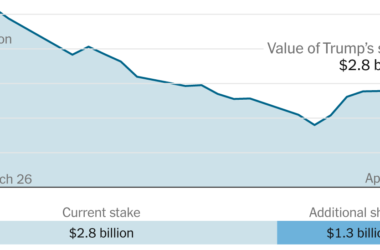A closely watched measure of inflation remained stronger than expected in March, worrying news for Federal Reserve officials who have become increasingly concerned that their progress on lowering price increases might be stalling.
The surprisingly stubborn inflation reading raised doubts among economists about when — and even whether — the Fed will be able to start cutting interest rates this year.
The Consumer Price Index climbed 3.8 percent on an annual basis after stripping out food and fuel prices, which economists do in order to get a better sense of the underlying inflation trend. That “core” index was stronger than the 3.7 percent increase economists had expected, and unchanged from 3.8 percent in February. The monthly reading was also stronger than what economists had forecast.
Counting in food and fuel, the inflation measure climbed 3.5 percent in March from a year earlier, up from 3.2 percent in February and faster than what economists have anticipated. A rise in gas prices contributed to that inflation number.
This week’s inflation figures come at a critical juncture for the Fed. Central bankers have been hoping to confirm that warmer-than-expected inflation figures at the start of the year were just a seasonal quirk, not evidence that inflation is getting stuck well above the 2 percent inflation target. Wednesday’s report offers little comfort that the quick early 2024 readings have not lasted.
“It is what it is: It’s a stronger than expected number, and it’s showing that those price pressures are strong across goods and services,” said Blerina Uruci, chief U.S. economist at T. Rowe Price. “It’s problematic for the Fed. I don’t see how they can justify a June cut with this strong data.”
Policymakers have made it clear in recent months that they want to see further evidence that inflation is cooling before they cut interest rates. Fed officials raised borrowing costs to 5.3 percent in 2022 and mid-2023, which they think is high enough to meaningfully weigh on the economy. Central bankers forecast in March that they will cut interest rates three times this year.
But Fed officials do not want to cut rates before they are confident inflation is on track to return to normal. Lowering borrowing costs too early or too much would risk allowing price increases to pick back up. And if households and businesses come to expect inflation to remain slightly higher, officials worry that could make it even harder to stamp out down the road.
That threat of lingering inflation has become a more serious concern for policymakers since the start of the year. Inflation flatlined in January and February after months of steady declines, raising some alarm at the Fed and among forecasters. Going into the year, investors expected the Fed to cut rates sharply in 2024 — to about 4 percent — but have steadily dialed back those expectations. Investors have recently begun to expect just two or three rate cuts.
Stocks futures dropped sharply following the inflation release as investors further pared back their expectations for lower rates.
Investors would like to see lower interest rates, which tend to bolster prices for assets like stocks. But the Fed might struggle to explain why it is cutting rates at the current moment: Not only is inflation showing signs of getting stuck well above the central bank’s target, but the economy is growing at a fairly rapid pace and employers are hiring at a robust clip.
In short, the Fed’s policies do not appear to have pushed America to the brink of a recession — and in fact, there are signs that they may not be having as much of an effect as policymakers had expected when it comes to growth.
While the Fed officially targets Personal Consumption Expenditures inflation, a separate measure, the Consumer Price Index report released on Wednesday comes out earlier and includes data that feeds into the other metric. That makes it a closely watched signal of how price pressures are shaping up.
The inflation report’s details offered little reason to dismiss the gauge’s continued stubbornness as a fluke. They showed that housing inflation remains firm, auto insurance costs picked up at a rapid pace and apparel prices climbed.
In a development that is likely to be especially notable for Fed officials, a measure of services inflation contributed to the pickup in annual inflation. Policymakers watch those prices closely, because they can reflect the strength of the underlying economy and because they tend to persist over time.
The question, increasingly, is whether Fed officials can cut interest rates at all this year in a world where inflation appears to be flatlining.
Ms. Uruci said that with every month inflation stays stubborn, the Fed may need to see more convincing evidence — and a more sustained return to deceleration — to feel confident that price increases are genuinely coming under control.
If the Fed does not cut rates soon, the election could make the start of reductions more politically fraught. Central bankers are independent of the White House and typically insist that they do not make policy with an eye on the political calendar.
Still, cutting in the months just before the election could put policymakers under a partisan spotlight: former President Donald J. Trump, the presumptive Republican nominee, has already painted possible rate cuts as a political ploy to help Democrats.
But given inflation’s unexpected staying power, the Fed is likely to want to take its time in adjusting policy. Kathy Bostjancic, Nationwide’s chief economist, said that rate cuts could now be delayed to this autumn — if they happen in 2024 at all.
“We now think September, if they start to cut rates, is more likely than July,” Ms. Bostjancic said. “It shakes the confidence that inflation is on this downward trend.”



